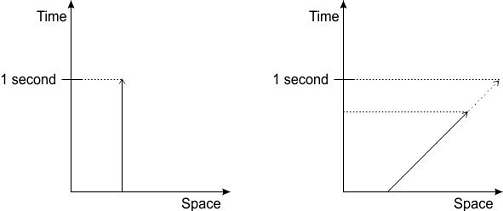Wow, more than a month has gone by since I last posted. Doesn't time fly! All this has got me thinking about the subject of time again, so I’ll be spending the next few posts back on the subject.
Let’s start by looking at some of the scientific views on time.
How fast you think we travel through time? You’d be right if you said one second per second, but that’s not always true. From Einstein’s Special Theory of Relativity, we know that objects in motion relative to one another measure each other’s time as differing from their own. If their relative motion is fast enough, they see each other as either moving too fast (if they are approaching one another) or too slow (if they’re moving apart). But which one is right? Einstein’s breakthrough was the simple insight that they are both right. There is no absolute motion, only relative motion, and therefore only relative time.
But that still doesn't answer the question of how fast we are moving through time. If time were a dimension like any of the other three that we know, how fast would we be moving along that dimension in one second? Another of the insights from Relativity Theory is the fact that we move along the time dimension at the speed of light. Any time when we are motionless, we are still moving because we are travelling along in time at light speed. In fact, no matter how we move or stay still, our total velocity is always light speed.
This explains why time appears to slow down when we are in very rapid motion. Let’s conduct a thought experiment.
Imagine you are standing on the Equator facing due north. You drive your car north at 50 miles an hour. This is the equivalent of standing still, while still travelling through time. You make a half-turn to the right, so that you are travelling at an angle of 45° from due north. You are now travelling through time and space at the same time. Your total speed is still 50 miles an hour. However, your speed to the north is now significantly less than 50 miles an hour. This is equivalent to time slowing down if you are travelling at a significant fraction of the speed of light. The diagrams below will perhaps make this a little easier to understand.
On the left, you are standing still, but still travelling in time. For you, one second takes the same time as for those observing you while not moving relative to you.
On the right, you are moving fast enough through space that time has apparently slowed down when viewed by outside observers. Both solid lines are exactly the same length, meaning that your total speed is exactly the same. However, you will notice that the amount of time that passes for you is less than one second in “objective” time. The figure represents a velocity of half the speed of light, at which point time slows down to just over 70%. You have to travel much further for one second of time to elapse for you.
Fortunately for us, we rarely achieve speeds fast enough for this to affect our lives. If you were to take a around the world trip in a jetliner, you would return to your starting point only a fraction of a microsecond younger than if you had stayed in place. However, it does allow short-lived particles to be observed for longer periods of time when they have a speed of 99.99% of light speed, as we can observe in such places as CERN.
Even if we could achieve high speeds, we wouldn't live any longer. For us, such a trip of 10 years would still be 10 years long, even if the rest of the world thought it had taken over 14. Conversely, if they thought it was 10 years long, it would only seem to have been just over 7 years long for us. It amounts to nothing more than a form of time travel into the future.
Next time, we’ll consider time from a biological point of view, as well as the differences between relativity’s and quantum theory’s views of time and events happening in time.
Category: Home > General Posts
Previous: Time vs. Time
Next: One Step at a Time

Trackbacks/Pingbacks